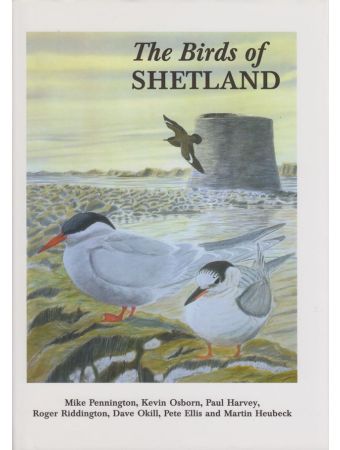THE BIRDS OF SHETLAND. By Mike Pennington, Kevin Osborn, Paul Harvey, Roger Riddington, Dave Okill, Pete Ellis and Martin Heubeck.
# 2004 1st edition. Large 8vo (178 x 252mm). Pp576. Colour and b/w photographs, b/w illustrations, graphs, tables, map end-papers, extensive bibliography. Blue boards, spine titled in gilt.
# "Shetland is the most northerly island group in Britain, lying 130 miles north of the Scottish mainland. There are around 100 islands in the archipelago, of which just 15 are inhabited. They are spectacularly beautiful, and hold a variety of interesting habitats. The archipelago is a famous among birders for its globally significant populations of breeding seabirds and its remarkable list of rare visitors. The Shetland breeding avifauna is less diverse than that of the mainland, but the islands do support many species uncommon or absent elsewhere in Britain. Twenty-one species of seabird breed, including all four auks, Great and Arctic skuas and Leach's Petrels, and almost all of Britain's breeding Red-necked Phalaropes are found on Fetlar. The islands also hold important breeding populations of various waders and wildfowl. In spring and autumn the islands are significant staging posts for migrants, including rarities. Fair Isle especially is a magnet for vagrants from both sides of the Atlantic. Rarities like Great Snipe, Citrine Wagtail and Lanceolated Warbler are found more often here than anywhere else in Britain, and the island has claimed many 'firsts for Britain'. This book represents a comprehensive overview of the status of every species recorded in Shetland. The accounts cover distribution and population trends, patterns in habitat use, and conservation. For rarities, a thorough breakdown of the records is presented and any trends or patterns discussed. The book includes introductory chapters on the islands' climate, vegetation, general ecology and history of land use, and their history of birding and conservation. It is illustrated with attractive line drawings, plus 40 pages of colour photographs. This is the definitive avifauna for Shetland, and will be invaluable to all birders and ornithologists with an interest in these wonderful islands." Contents include:- Forewords by Dennis Coutts and Roy Dennis; Acknowledgements; Introduction by Kevin Osborn; Geographical overview of Shetland by Mike Pennington; Human impact on the Shetland avifauna by Paul Harvey; Breeding birds by Paul Harvey and Martin Heubeck; Wintering birds by Paul Harvey; Migration by Kevin Osborn and Mike Pennington; The birdwatchers by Mike Pennington. These chapters cover the first 64 pages of the book. This is followed, from pages 65 to 530, by the Systematic List of the Birds of Shetland with contributions from all seven authors. Mike Pennington then contributes two further chapters to close the book: Escapes and failed introductions, and, Errors, unconfirmed and other unacceptable records. Appendices include:- Shetland bird names; Gazetteer; Scientific names of plants and animals referred to in the text; Officers and wardens; Notable 2003 records. The book concludes with an eighteen page bibliography.
# "Shetland is the most northerly island group in Britain, lying 130 miles north of the Scottish mainland. There are around 100 islands in the archipelago, of which just 15 are inhabited. They are spectacularly beautiful, and hold a variety of interesting habitats. The archipelago is a famous among birders for its globally significant populations of breeding seabirds and its remarkable list of rare visitors. The Shetland breeding avifauna is less diverse than that of the mainland, but the islands do support many species uncommon or absent elsewhere in Britain. Twenty-one species of seabird breed, including all four auks, Great and Arctic skuas and Leach's Petrels, and almost all of Britain's breeding Red-necked Phalaropes are found on Fetlar. The islands also hold important breeding populations of various waders and wildfowl. In spring and autumn the islands are significant staging posts for migrants, including rarities. Fair Isle especially is a magnet for vagrants from both sides of the Atlantic. Rarities like Great Snipe, Citrine Wagtail and Lanceolated Warbler are found more often here than anywhere else in Britain, and the island has claimed many 'firsts for Britain'. This book represents a comprehensive overview of the status of every species recorded in Shetland. The accounts cover distribution and population trends, patterns in habitat use, and conservation. For rarities, a thorough breakdown of the records is presented and any trends or patterns discussed. The book includes introductory chapters on the islands' climate, vegetation, general ecology and history of land use, and their history of birding and conservation. It is illustrated with attractive line drawings, plus 40 pages of colour photographs. This is the definitive avifauna for Shetland, and will be invaluable to all birders and ornithologists with an interest in these wonderful islands." Contents include:- Forewords by Dennis Coutts and Roy Dennis; Acknowledgements; Introduction by Kevin Osborn; Geographical overview of Shetland by Mike Pennington; Human impact on the Shetland avifauna by Paul Harvey; Breeding birds by Paul Harvey and Martin Heubeck; Wintering birds by Paul Harvey; Migration by Kevin Osborn and Mike Pennington; The birdwatchers by Mike Pennington. These chapters cover the first 64 pages of the book. This is followed, from pages 65 to 530, by the Systematic List of the Birds of Shetland with contributions from all seven authors. Mike Pennington then contributes two further chapters to close the book: Escapes and failed introductions, and, Errors, unconfirmed and other unacceptable records. Appendices include:- Shetland bird names; Gazetteer; Scientific names of plants and animals referred to in the text; Officers and wardens; Notable 2003 records. The book concludes with an eighteen page bibliography.
£40.00
Availability:
In stock
Book Code
58001
| Author | Pennington (Mike), Osborn (Kevin), Harvey (Paul), Riddington (Roger), Okill (Dave), Ellis (Pete) and Heubeck (Martin). |
|---|---|
| Book Code | 58001 |
| ISBN | 0713660384 / 0713660384. |
| Book Description | Fine copy in dust-wrapper. |
| Book Cover | Hardcover |
| Published Date | 2004 |
| Publisher | Christopher Helm. |
| Place | London. |




